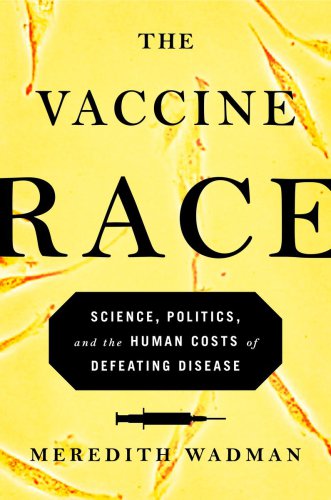
The Vaccine Race
Science, Politics, and the Human Costs of Defeating Disease
علم، سیاست و هزینههای انسانی از بین بردن بیماری
کتاب های مرتبط
- اطلاعات
- نقد و بررسی
- دیدگاه کاربران
نقد و بررسی

Starred review from December 12, 2016
Wadman, staff writer for Science, depicts the cutthroat competition, ugly politics, brilliant science, and questionable ethics that underscored the research and development, during the 1960s and ’70s, of vaccines that have protected many millions of Americans from rubella, polio, rabies, and other diseases. She provides an excellent introductory primer on cell biology to complement colorful sketches of the personalities of the pioneering biologists who produced the first live vaccines while challenging scientific tenets and medical ethics. The book is not for the squeamish. Wadman details the surgical and laboratory processes scientists used to develop vaccines, and describes the testing of vaccine prototypes on both children and adults—done mostly without their consent, in orphanages, asylums, schools, and prisons. She also documents the beginnings of the biotechnology industry in the 1980s and the concomitant rise and fall of Leonard Hayflick, who created the crucial WI-38 cell strain and entered into multi-million dollar business agreements before coming under investigation by the National Institutes of Health and getting embroiled in a much-publicized court battle with the U.S. government over ownership of the valuable cells. This is an exemplary piece of medical journalism, and Wadman makes strikingly clear the human costs of medical developments as well as the roles of politics and economics.

Starred review from December 15, 2016
A dramatic medical history that reveals the progress and the stumbles, the personalities and the rivalries, in the race to find a vaccine for rubella, or German measles. Science magazine writer Wadman, who has a medical degree from Oxford and a journalism degree from Columbia, has long covered the politics of biomedical research. As she makes immediately clear, rubella, like Zika, inflicts terrible damage on babies whose mothers are infected during their pregnancies. In the 1960s, the search for a safe and effective vaccine was just beginning. Wadman focuses on Leonard Hayflick and Stanley Plotkin, scientists at the Wistar Institute of Anatomy and Biology at the University of Pennsylvania, and cell line WI-38, derived from the lungs of a fetus legally aborted in Sweden (and used without the mother's consent), which subsequently became key to developing a vaccine that has been given to hundreds of millions of people. Besides informing readers of the role of fetal tissue in biomedical research, the author reveals the shocking methods used by researchers to test vaccines: prior to today's stringent laws about informed consent, the test subjects were often institutionalized mentally disabled children. Rivalries and shenanigans abound in Wadman's complex story. One night, Hayflick removed ampules of the cell line from the lab at Wistar, packed them up in his car, and carried them to his new job at Stanford University. Accusations and lawsuits ensued, as well as struggles for funding, and pharmaceutical companies and government agencies eventually became major players. Wadman's story is much more than just the rubella story, however, for it doesn't end with that vaccine. Strains derived from WI-38 are used today in the manufacture of most human virus vaccines, including those for polio, shingles, mumps, rabies, and hepatitis, and Hayflick's work with cell biology has led to discoveries that have significant implications for theories of human aging. An important story well told, featuring the drama and characters needed to make this a candidate for film adaptation.
COPYRIGHT(2016) Kirkus Reviews, ALL RIGHTS RESERVED.

January 1, 2017
Today, many take for granted that the vaccines administered to prevent measles, mumps, and other diseases are safe and effective. How they got that way is at the center of this compelling account of the development of the first polio, rubella, and rabies vaccines. Wadman, a biomedical reporter who has contributed to Science, Nature, and other publications, concentrates her work on a group of vaccine researchers at the Wistar Institute of Philadelphia in the 1960s and 1970s. Each of these driven, ambitious men hoped to be the first to create a new or better vaccine. Another crucial part of the narrative concerns the development of WI-38--a controversial human fetal cell line still used today to isolate and grow viruses. The author also examines the disturbing practice of testing experimental vaccines on orphans, prisoners, and others before informed consent was mandatory. The basic facts and events of this period in vaccinology history are enlivened by the vivid recollections of key individuals interviewed at length by the author. VERDICT Highly recommended for readers who enjoy medical breakthrough stories such as Thomas Hager's The Demon Under the Microscope and studies of medical research ethics, including Rebecca Skloot's The Immortal Life of Henrietta Lacks. [See Prepub Alert, 8/26/16.]--Cynthia Lee Knight, Hunterdon Cty. Historical Soc., Flemington, NJ
Copyright 2017 Library Journal, LLC Used with permission.

























دیدگاه کاربران